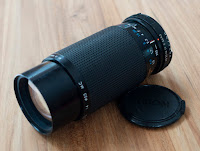Cost: $19.99 (market price likely under $20)
I strongly suspect this lens was actually made by Cosina, and rebranded as Magnicon for Black's Photography, and also sold under other brand names such as Vivitar. The Cosina native version, and the Vivitar version have a good reputation, but I was less impressed with the Magnicon version. Not sure if anything was changed to the design to reduce cost for Black's Photography, but I'm gussing this one was mainly sold as a standard kit lens.
Although I'm not a huge fan or rubber on lenses, the lens looks OK, like a regular of-the-mill manual zoom lens. Both zoom and aperture rings are smooth, and there does not seem to be a lens creep that is often the case on cheaper push/pull zoom lenses.
With a variable maximum aperture of 3.5 to 4.8, this is not a fast lens. And it shows... it's much harder to get sharp handheld pictures on a dreary day. Even when I was able to get a good shutter speed, I was still not impressed with sharpness or resolution. It also looses some sharpness closer to the edge. I also found the color to be a little bleak, but that might just have been the conditions of the shoot. On the plus side, I found little color aberration.
So, as a kit lens, it's not to bad. Maybe good as a starter or for a trip where you would not mind loosing your equipment, but as collector's item, or as a replacement lens, I would avoid it. Unless you happen to collect some Canadian photography history.
Lens Specification:
Focal Length: 35-70mm
Maximum Aperture: F3.5-4.8
Minimum Aperture: F22
Image Format: 35mm
Lens Mount: MD
Optics: 7 elements in 7 groups (not confirmed)
Blades: 6
Focussing: Manual
Minimum Focus: 40cm
Filter Size: 49mm
Weight: 286g
Length: 69-83mm
Production: 1986?
Serial Number: 9031574
Made in: Japan
Samples
| 1/640 sec - ISO100 - Handheld |
| 1/60 sec - ISO125 - Handheld |
| 1/100 sec - ISO100 - Handheld |
| 1/60 sec - ISO100 - Handheld |
| 1/60 sec - ISO500 - Handheld |
| 1/60 sec - ISO160 - Handheld |
| 1/80 sec - ISO100 - Handheld |
| 1/60 sec - ISO160 - Handheld |
| 1/60 sec - ISO100 - Handheld |
| 1/640 sec - ISO100 - Handheld |
| 1/60 sec - ISO125 - Handheld |































